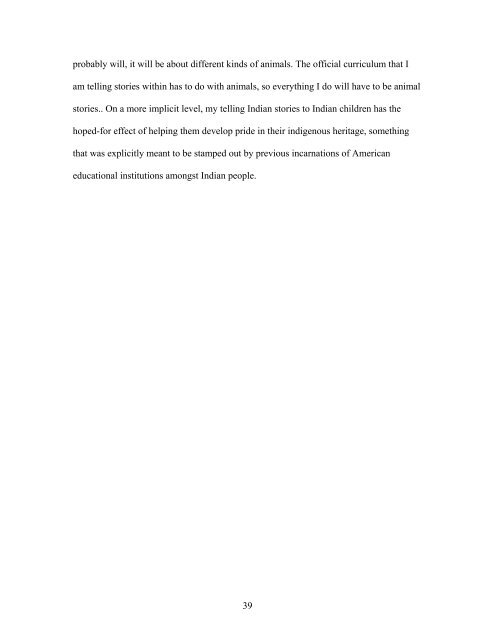The Intersection of Karuk Storytelling and Education
The Intersection of Karuk Storytelling and Education The Intersection of Karuk Storytelling and Education
probably will, it will be about different kinds of animals. The official curriculum that I am telling stories within has to do with animals, so everything I do will have to be animal stories.. On a more implicit level, my telling Indian stories to Indian children has the hoped-for effect of helping them develop pride in their indigenous heritage, something that was explicitly meant to be stamped out by previous incarnations of American educational institutions amongst Indian people. 39
Chapter 6: Conclusion Educational forms have had a pervasive impact on Káruk storytelling from classic times to the present. In classic Káruk culture, storytelling was one part of a broad educational structure that ranged from the sweathouses and villages on the creeks and River, to the high spiritual places in the mountains. Storytelling was often used to help students find their way from the villages to the mountains and back again in an effort to learn more about themselves, about why they were in the world, and how they fit into a cultural complex based around High Dance or World Renewal ceremonies. American education, in policy and often in practice, meant to annihilate these stories and the culture they were a part of, replacing them with American stories and cultural practices. America cannot exist without appropriating other people’s countries, and in the effort of nationbuilding and nation-sustaining, it must negate competing claims to those lands. The powerful bond between Káruk culture, with its partner constituents education and storytelling, constitutes such a claim. As such, America used education and storytelling to assimilate Káruk-varâaras into mainstream American society. The educational system began as the segregated Indian boarding schools, but progressed into integrated public schools. But the same stories were generally still told, especially the American myths of Manifest Destiny and the Vanishing Indian. The first is told to establish American title to the continent, the second to negate those of indigenous peoples. As can be expected, Indian culture didn’t fare well with the children being indoctrinated with these stories. This, however, was accompanied by another trend, one that subverted it. This trend involved Káruk-varâaras continuing to speak our language, tell our stories, and sometimes use sweathouse and practice mountain training. (cf. Buckley 2002) But it also 40
- Page 1 and 2: Stony Brook University The official
- Page 3 and 4: Copyright by Waylon Conrad Lenk 201
- Page 5 and 6: Abstract of Thesis The Intersection
- Page 7 and 8: Dedication Page This thesis is dedi
- Page 9 and 10: List of Figures Fig. 1. The Hover C
- Page 11 and 12: making the world a more beautiful p
- Page 13 and 14: seven minutes, three-quarters of th
- Page 15 and 16: am a Káruk-ára from the villages
- Page 17 and 18: The Káruk-aráara have lived on th
- Page 19 and 20: Chapter 2: Classic Káruk Education
- Page 21 and 22: made at Weɫkwäu at the mouth of t
- Page 23 and 24: wealth. A key to understanding indi
- Page 25 and 26: activity between menstruating women
- Page 27 and 28: structure. As such, it would be cou
- Page 29 and 30: 19 th century American theorist Lew
- Page 31 and 32: mainstream American life, the feder
- Page 33 and 34: Or, more to the point, “I am the
- Page 35 and 36: pedagogically linked to both Arnold
- Page 37 and 38: movement that coincided with the re
- Page 39 and 40: precursor to his later book with Gi
- Page 41 and 42: second books is merely a continuati
- Page 43 and 44: Chapter 5: Modern Era Public school
- Page 45 and 46: University who hoped to excavate gr
- Page 47 and 48: Language Program at Hoopa High Scho
- Page 49: were selected from received oral an
- Page 53 and 54: Bibliography Adams, David Wallace.
- Page 55 and 56: Kroeber, A. L. “Elements of Cultu
probably will, it will be about different kinds <strong>of</strong> animals. <strong>The</strong> <strong>of</strong>ficial curriculum that I<br />
am telling stories within has to do with animals, so everything I do will have to be animal<br />
stories.. On a more implicit level, my telling Indian stories to Indian children has the<br />
hoped-for effect <strong>of</strong> helping them develop pride in their indigenous heritage, something<br />
that was explicitly meant to be stamped out by previous incarnations <strong>of</strong> American<br />
educational institutions amongst Indian people.<br />
39



